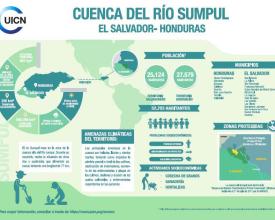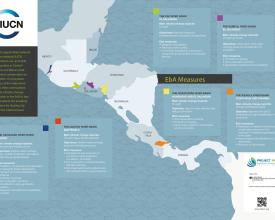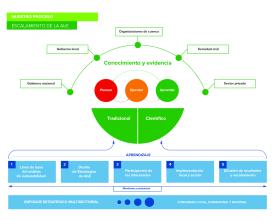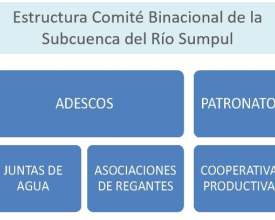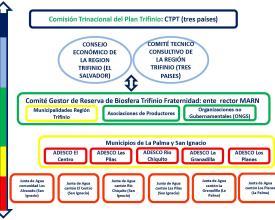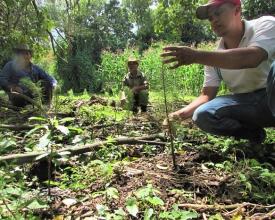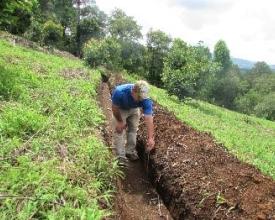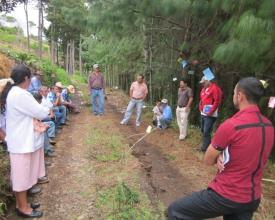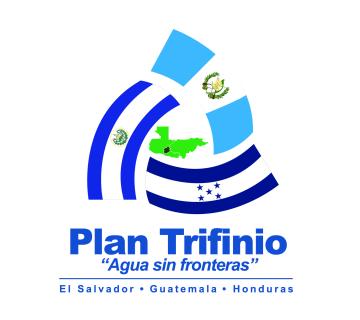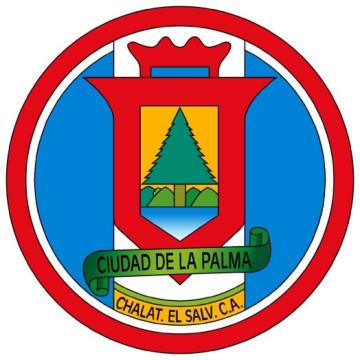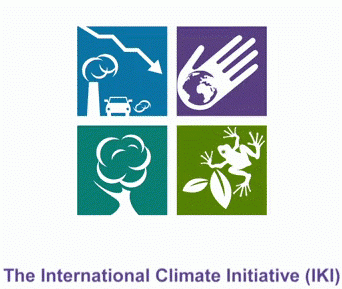
Renforcement de la gouvernance à plusieurs niveaux pour l'EbA dans le sous-bassin binational de la rivière Sumpul (El Salvador-Honduras)

La pénurie d'eau et les droits d'utilisation de l'eau ont entraîné des conflits dans les eaux d'amont du sous-bassin de la rivière Sumpul (867 km2), partagé entre le Honduras et le Salvador. Le contexte du changement climatique rend cruciale la recherche de solutions intégrales qui génèrent la paix, le développement transfrontalier et la résilience.La promotion d'un modèle de gouvernance multidimensionnel (multiniveaux et multisectoriel), participatif et flexible, avec une approche écosystémique, pour l'adaptation est donc une étape importante. En cherchant à faire de l'utilisation durable de l'eau un besoin d'adaptation à Sumpul, les structures de gouvernance existantes ont été renforcées, en améliorant leur représentation, leurs connaissances et leur capacité de gestion. Un programme commun a été élaboré sur la base d'un dialogue et d'une confiance accrus entre les parties prenantes du sous-bassin supérieur, sous l'égide du comité communautaire binational. Ce programme comprenait la mise en œuvre de systèmes agroforestiers et de pratiques de conservation des sols afin de garantir les services écosystémiques de l'eau.
Contexte
Défis à relever
- Le sous-bassin est confronté à une dégradation de l'environnement due à la déforestation et à la contamination des sols et de l'eau par l'agriculture.
- La nature binationale du bassin implique des défis de collaboration et de coordination entre le Honduras et le Salvador. Ce n'est que du côté hondurien qu'il existe un cadre juridique spécifique pour la gestion intégrée des ressources en eau et la gouvernance des bassins versants
- Il existe des conflits historiques sur l'utilisation de l'eau, principalement au niveau communautaire ou local, mais avec un intérêt binational.
- Les principales menaces climatiques sont les suivantes : fortes variations du régime des précipitations, fluctuations extrêmes de température ("gelées") et vents violents ; glissements de terrain, inondations et sécheresses récurrentes. Tous ces phénomènes causent des dommages aux infrastructures, à la production alimentaire et aux moyens de subsistance locaux, et contribuent à aggraver la pauvreté et la migration des populations.
- Il y a peu d'articulation entre la gestion des ressources en eau et les connaissances limitées des décideurs et des dirigeants locaux en matière d'adaptation basée sur les écosystèmes pour la sécurité de l'eau.
Emplacement
Traiter
Résumé du processus
La gouvernance pour l'adaptation fait référence aux normes, institutions et processus qui déterminent comment le pouvoir est exercé, les responsabilités sont distribuées et les décisions sont prises pour faire face au changement climatique. Cette solution préconise un modèle de gouvernance pour l'adaptation qui soit multidimensionnel (BB1), participatif (BB2), flexible (BB3) et basé sur une approche écosystémique.
Pour renforcer la gouvernance adaptative dans la partie supérieure de la rivière Sumpul, les structures de gouvernance communautaire ont été soutenues, en particulier les comités de l'eau et le comité communautaire binational du sous-bassin supérieur (BB1).
La création de capacités, la promotion du leadership et l'établissement d'un consensus au sein des structures de gestion de l'eau constituent la base de résultats durables à l'avenir (BB2). Les capacités doivent être pratiques, impliquer une approche multidimensionnelle et produire des résultats à court terme. Grâce aux capacités, les organisations sont en mesure de développer des instruments de gestion et de politique, alimentés par des études scientifiques et des connaissances locales (BB3).
Blocs de construction
Gouvernance multidimensionnelle pour l'adaptation des ressources en eau
La gouvernance multi-niveaux et multisectorielle pour l'adaptation implique de travailler à plusieurs niveaux et avec différents secteurs. Elle nécessite de créer des connexions pour une meilleure articulation entre les acteurs territoriaux.
Dans la partie supérieure du sous-bassin de la rivière Sumpul, il s'agissait de travailler en étroite collaboration avec les organisations de base (communautaires) pour développer une gestion ascendante des ressources en eau. Cela a été fait en soutenant la création de comités de l'eau liés aux associations de développement communautaire (ADESCO), aux municipalités et au comité de la communauté binationale.
Les capacités de 4 comités de l'eau et leurs systèmes d'approvisionnement ont été renforcés et ont ensuite été formalisés dans le cadre de la gouvernance municipale.
En outre, conformément à l'approche de la gouvernance à plusieurs niveaux, le Comité communautaire binational a été renforcé par des conseils de restructuration, des formations, de nouveaux outils de gestion et des liens plus étroits avec les gouvernements municipaux. Ce comité s'occupe désormais des questions relatives à l'eau dans les communautés afin de prévenir les conflits liés à l'utilisation de l'eau.
Facteurs favorables
- le cadre juridique du Honduras (loi générale sur l'eau) qui définit différentes structures de gouvernance des bassins hydrographiques ; et au Salvador, la réglementation des comités de l'eau de l'ADESCO, avec un mandat de santé publique.
- L'existence du comité binational a été déterminante, car le travail n'est pas parti de zéro, mais s'est plutôt concentré sur leur renforcement et leur restructuration, respectivement.
- L'articulation des efforts des projets et des organisations sur un territoire est fondamentale (par exemple entre l'UICN et le Plan Trifinio).
Leçon apprise
- Le renforcement des structures locales et communautaires existantes est essentiel, car elles ont la capacité de soutenir les progrès et les changements réalisés sur le territoire, malgré l'alternance des autorités locales.
- Les ADESCO et le Comité de la communauté binationale assument des tâches de médiation importantes, car la gestion des ressources en eau peut générer des conflits en raison de la diversité des intérêts qui convergent sur cette question.
- L'articulation des efforts des projets sur un territoire est fondamentale (par exemple entre les projets AVE et BRIDGE) pour obtenir des impacts et des efficacités plus importants, grâce à des agendas de projet coordonnés.
- Le projet BRIDGE dans le bassin du fleuve Goascorán (El Salvador-Honduras) a permis de tirer la leçon suivante, qui est également pertinente dans le cas présent : "La diplomatie de l'eau ne suit pas nécessairement un chemin tout tracé. Pour être efficaces, les stratégies doivent intégrer des dimensions multiples et une approche progressive, en reliant les structures existantes et émergentes dans le bassin."
Renforcement des capacités pour garantir l'approche écosystémique
Pour améliorer la gouvernance locale dans la rivière Sumpul, il était essentiel d'intégrer l'approche écosystémique dans la gestion des terres et de former en conséquence les structures de gouvernance locale de l'eau, les autorités locales et les agriculteurs. Ensemble, ils mettent en œuvre des mesures d'EbA pour faire face à la sécheresse et à la variabilité, telles que des pratiques de conservation des sols, la protection des sources d'eau et la mise en place de systèmes agroforestiers.
Le renforcement des capacités a été dispensé à
- >100 agriculteurs par le biais d'une approche d'apprentissage par la pratique afin d'obtenir des résultats démonstratifs sur le terrain. Les mesures EbA mises en œuvre se sont concentrées sur les services écosystémiques de l'eau et du sol, sur la diversification de la production et sur l'atténuation des impacts du changement climatique et de la variabilité (vents et précipitations extrêmes) sur les cultures et les biens, ainsi que sur l'amélioration de l'infiltration et de la disponibilité de l'eau dans la région.
- Les comités de l'eau ont été formés aux compétences d'organisation et de gestion ainsi qu'à la gestion intégrale de l'eau, afin de les amener à comprendre l'importance des services écosystémiques de l'eau.
- Les dirigeantes et les agricultrices ont été formées aux techniques de communication.
- Des fonctionnaires municipaux ont participé à une formation régionale sur l'adaptation au changement climatique et à un échange d'expériences avec 30 autres gouvernements locaux de Méso-Amérique.
Facteurs favorables
- Les synergies avec les projets existants et les organisations locales telles que Plan Trifinio ont été cruciales.
Leçon apprise
- Les échanges d'expériences contribuent aux processus de formation et motivent les participants à prendre part à la gouvernance de l'eau et à reconnaître la valeur d'apprentissage des actions menées.
- Le renforcement des capacités des organisations locales est essentiel pour garantir la fourniture de services écosystémiques liés à l'eau et constituera toujours un bon investissement.
Développer des cadres de gouvernance flexibles pour l'adaptation
La gouvernance pour l'adaptation nécessite des cadres politiques et juridiques flexibles. Par conséquent, les plates-formes de gouvernance du sous-bassin supérieur nécessitaient des instruments de gestion permettant de valoriser et d'institutionnaliser les options d'adaptation et les formes de gouvernance apportant les plus grands avantages socio-environnementaux. Les règlements intérieurs de plusieurs comités ADESCO pour l'eau et du comité de la communauté binationale du sous-bassin ont été rédigés, ce dernier ayant également mis à jour son plan stratégique (plan quinquennal) et son plan opérationnel annuel.
Le processus a pris en compte les nouvelles dynamiques et tendances dans le sous-bassin, ainsi que l'approche EbA. La formulation de politiques municipales a également été soutenue (plans d'adaptation locaux pour La Palma et San Ignacio, El Salvador). Étant donné que l'adaptation au changement climatique est entourée d'une série d'incertitudes quant aux impacts climatiques futurs et aux trajectoires de développement, ces cadres et instruments doivent être en constante évolution, en tenant toujours compte des leçons tirées des expériences sur le terrain et de la gouvernance. De cette manière, l'adaptation au changement climatique peut progresser dans le cadre d'une approche flexible et, grâce à des cycles itératifs, générer des stratégies à court terme en fonction des incertitudes à long terme.
Facteurs favorables
- La présence continue et l'enracinement dans le territoire du Plan Trifinio est un puissant facteur d'habilitation qui offre une certaine souplesse dans la prise de décision et permet également une mise à l'échelle verticale. Cette entité trinationale travaille en étroite collaboration avec les communautés et connaît bien le territoire, tout en ayant un poids politique et un effet de levier auprès des autorités, puisqu'elle fait partie du système d'intégration centraméricain et qu'elle est présidée par les vice-présidents et le délégué présidentiel de trois pays (le Salvador, le Guatemala et le Honduras).
Leçon apprise
- Le sous-bassin du Sumpul dispose d'un Plan de Gestion Intégral dont la mise en œuvre incombe à l'ensemble des acteurs du sous-bassin et qui pourrait être revitalisé sur la base des progrès réalisés en matière d'EbA et du renforcement de la gouvernance pour l'adaptation. Une gouvernance flexible devrait envisager le suivi, l'évaluation et la mise à jour de ce Plan de Gestion Intégral sur la base des leçons tirées des projets mis en œuvre.
- Les nouveaux instruments de gestion préparés par les plateformes de gouvernance du sous-bassin devraient à l'avenir être évalués pour déterminer leur efficacité en tant que réponses à l'adaptation. Tout ajustement résultant de cette analyse sera le signe d'une gouvernance flexible.
Impacts
Amélioration de la gouvernance locale de l'eau
- Relance et consolidation du Comité communautaire binational du sous-bassin de la rivière Sumpul
- Renforcement de 4 comités de l'eau qui gèrent les systèmes d'approvisionnement en eau pour la consommation humaine.
- Développement de nouveaux instruments de planification et de gestion pour les plateformes de gouvernance locale (comité binational et 4 comités de l'eau).
- Meilleure articulation entre les acteurs clés autour de la gestion intégrée des ressources en eau dans le sous-bassin.
- Participation active des jeunes et des femmes aux comités de l'eau et à d'autres entités locales.
Amélioration des connaissances et des capacités locales
- Les membres des comités ont été formés à la coopération transfrontalière, à la gestion intégrée des ressources en eau, à l'adaptation fondée sur les écosystèmes (EbA), ainsi qu'aux cadres politiques et à la législation en matière d'eau et de changement climatique.
- Des compétences accrues en matière de communication et de plaidoyer, après la formation de 38 dirigeants communautaires à la négociation, à l'influence sur les politiques et à la communication.
- Amélioration des capacités de mise en œuvre de l'EbA de plus de 100 agriculteurs.
Bénéficiaires
- >100 agriculteurs et leurs familles bénéficiant d'un soutien technique pour les actions EbA
- 4 comités de l'eau dotés de compétences organisationnelles
- Comité communautaire binational de Sumpul et municipalités de La Palma et San Ignacio (SV) et Sinuapa (HN) impliqués dans la formation
Objectifs de développement durable
Histoire
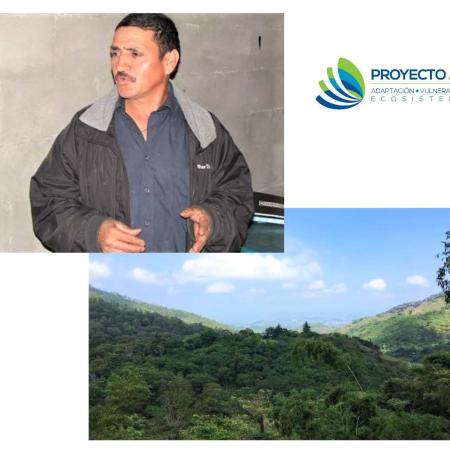
M. Teodoro Romero V., président de l'ADESCO et membre du Comité de l'eau et du Comité binational du bassin supérieur du fleuve Sumpul :"À l'origine, [Los Alvarados] était un hameau sans eau, bien qu'il ait comme source le fleuve Sumpul, que la communauté du Honduras utilisait depuis 50 ans. Après avoir décidé de puiser de l'eau dans cette rivière, nous avons commencé à avoir des problèmes, des conflits, des discussions [...]. "
Plutôt qu'un élément conflictuel, l'eau doit être un élément intégrateur, car elle permet aux communautés de communiquer et de s'unir pour obtenir un accès équitable et solidaire. Face aux menaces que représente le changement climatique, il est possible de parvenir à des accords en adoptant une vision communautaire et une attitude de dialogue dans la résolution des conflits. Ainsi, les communautés de San Francisco Sumpul (Honduras) et du hameau de Los Alvarados (Salvador) sont passées d'une situation de confrontation à la compréhension du fait que chacun est responsable du respect du droit à l'eau et, par conséquent, de l'intégrité des personnes et des écosystèmes.
Ils ont constaté qu'une meilleure connaissance permet une meilleure prévention et que, pour l'adaptation au changement climatique, il est important d'intégrer d'autres acteurs dans ce processus de prévention. C'est pourquoi Plan Trifinio et l'UICN ont impliqué non seulement les dirigeants des deux communautés, mais aussi la mairie et d'autres organisations, gouvernementales et non gouvernementales.
"L'un des problèmes que nous avons rencontrés au début, avoue Teodoro,était la méfiance ou la prudence dont les gens faisaient preuve en participant aux réunions. Heureusement, cette méfiance a été surmontée une fois que la nécessité de participer aux réunions a été acceptée."
Avec le temps, l'ADESCO (Association de développement communautaire) de Los Alvarados et son comité de l'eau sont nés. "Nous avons essayé d'établir un règlement participatif afin de gérer et d'utiliser l'eau de manière efficace et efficiente".
"L'un des premiers résultats, poursuit-il,a été l'approvisionnement en ce liquide vital, il y a trois ans, un effort qui durait depuis 12 ans. Deuxièmement, nous renforçons notre organisation et troisièmement, nous sensibilisons la communauté afin de créer un fonds pour maintenir le système. Aujourd'hui, nous vivons dans de meilleures conditions, l'eau et l'assainissement étant des éléments essentiels du développement de la communauté.

